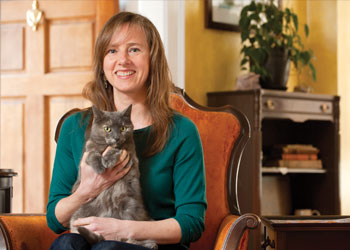
Tracking the bond
Human relationships with animals trace back to ancient civilizations. Julie Urbanik, Ph.D., assistant professor in UMKC’s Department of Geosciences, teaches a class about the study of human-animal relationships and animals in society. Her students study companion animals, pet ownership, the pet industry, farmed animals, animal mascots, wild animals, trade and biodiversity. Urbanik says pets are pervasive in all cultures—some of the earliest pet keepers were the Aborigines in eastern Australia. In South America, people kept rabbits and llamas as pets. In Africa, monkeys were pets. Some cultures used dogs as working animals, and over time, Urbanik says, people developed relationships with them, creating a bond.
Urbanik says the world’s population shift from rural to urban environments has caused an increase in pet ownership. Because most of the world’s population lives within urban areas, pets become surrogates for experiences with wildlife. Also, an increase in disposable income means some people can care for pets like they were their children. “The boom in the pet care industry is recent,” Urbanik says. “The industry has made incredible advances in technology and treatment methods, and our mindset of pets as family members means we want the best available care for them.”
Also, animals have now penetrated what in the past have been human-only industries. There are now pet cemeteries, pet loss support groups and doggy daycare. Some people include pets in their wills. New York hotel heiress Leona Helmsley, who died in 2007, bequeathed the bulk of her estate—about $12 million—to her dog, a Maltese named Trouble. This inclusion of pets in multiple facets of human life, Urbanik says, interacting with pets in public, taking the dog with you everywhere you go, tells the world, “We’re a unit.”
What fuels the love
Today, the human-animal bond has evolved to support a person’s innate need to care for things, people and animals. Robertson says when a pet gives us unconditional love, we want to do everything we can to give back to it because we are limited in what we can provide for the animal. Couple that with how some people view pets as part of the family, and pets can give people a sense of purpose. Our basic human needs, like living in a pack setting and around others, encourages the human-animal bond. “We are intensely curious and have a need to experience other species,” she says. “We need companionship and we need control.”
But there’s more going on behind the whiskers and wet noses that perpetuates the relationship—the feelings go both ways. The mutually beneficial relationship rewards pets for being our companion. In return, they get love and their basic needs met, and experts say animals are like us in many ways. Animals grieve when people get sick and they worry when an owner is gone. “We don’t give enough credit to our animals,” Robertson says.
“Research is supporting this now—they have cognitive thought. They have grieving periods when they lose another animal or person in the home.” Animals also share our feelings of survival and the need to be around the pack. “It’s not just a one-way relationship,” she says. “I have a client who lived with her father 10 years ago—the father had not seen her dog in that time. He walked in the house and the dog got excited, exuberant, and this is a dog that typically isn’t excited to have visitors. There’s definitely memory, emotional ties, loyalty, whatever you classify it as. They give back to us.”
